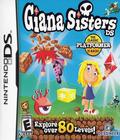The Great Giana Sisters is a piece of software — and industry lore — fondly remembered by platformer aficionados across Europe. In the late 1980s, it was released for a variety of home computers, including the Amiga and Commodore 64. In terms of level design and mechanics, it came so close to the original Super Mario Bros. that Nintendo themselves took notice and made moves to have it banned from sale shortly after its release.
I say all of the above not only to be informative, but to let you know straight out: Due to its history as a direct competitor and somewhat-ripoff, Giana Sisters DS will unavoidably be compared to the Super Mario series. The surprising part is that it actually holds up, even given this extra scrutiny.
Like its ancestor, Giana Sisters DS is a clone of the first Super Mario Bros., down to the item blocks, the power-ups, and the giant green dragon you fight at the end of every world. It also brings newer gimmicks into the mix, such as the "red coins" (or "red diamonds," in this case), which can be collected to open secret stages in each world. However, Giana Sisters also changes up a couple of the basic mechanics to keep things from becoming stale. Broken blocks can sometimes become footholds; power-ups keep you the same size. Interestingly enough, running and sliding are nowhere to be found, yet triangle jumps are much easier. Giana actually has significantly more freedom in her air movement than Mario ever did in the '80s, at the cost of ground mobility.
The stages are also shorter, which allows for denser challenges that end just when they've frustrated players the most. These challenges, however, do take a while to appear. The first two worlds prove almost laughably easy for seasoned platforming gamers. However, the difficulty visibly ramps up between the third and fifth worlds, providing a much more satisfying experience for those who love to overcome adversity. More challenging are the hidden special stages, both in terms of unlocking (gathering red diamonds, which are hidden in precarious places within every stage) and the stage layouts themselves. For those who consider such prospects too daunting, however, fear not: Continues are unlimited. On the whole, Giana's 80 stages are well designed and make sense. Some of the later entries feel a bit cheap in design — enough to remind you that you're not playing an impeccably polished Mario title — but few fall into this trap, and none are insurmountable.
Rounding out the gameplay package are three power-ups: one a Mario mainstay, the two debutante. Should Giana pick up a small rolling ball — known as a Punk Upgrade — from an item block, she turns into a punky version of herself who is able to throw (non-bouncing) fireballs. Bubble Gum allows her to freely fly while encased in a bubble (something sorely missed in post 16-bit 2-D Mario games), and Soda Bottles are multipurpose, allowing Giana to push back enemies, break down block walls, and put out fire hazards.
When the aforementioned power-ups combine with the well-done stage design, Giana truly feels like a lost Mario chapter in terms of playability. What breaks the illusion, however, are its looks and sounds, which have yet to be widely used in any 2-D Mario game to date. Graphically, at no point does Giana Sisters DS appear ashamed of its two-dimensional nature; backgrounds animate with shining sunbeams and clouds, and multilayered parallax scrolling. Weather effects, such as rain and snow, are also convincingly added to some stages, pulling off a beautiful sense of atmosphere.
Where this game utterly trumps the aesthetic direction of 2-D Mario games, however, is the absolutely uplifting soundtrack. This might seem like a small thing at first, but think back to the catchiness of the music of earlier Mario games. Then listen to this. I don't care what anybody says; that's just not a tune that makes you want to go on an adventure so much as fall asleep at the controls. This is ... and in Giana, so is this. The soundtrack is heavenly, and the thought of hearing more of it goes a great deal toward keeping the game in my system. As a longtime Sonic player, I simply have no time for substandard music in my platformers; fortunately, Giana measures up in every respect.
Giana Sisters DS is a game full of surprises. It first surprises with design competence in the face of its greatest competitor; it then continues to surprise with its charm, and flourishes with its soundtrack. It doesn't quite feel like something that can topple the big-name platforming icons yet; Mario, Kirby, Sonic, Meat Boy, etc., are hardly in trouble at the moment. However, this is a more than solid start, and if Giana can build on it in future games, she will absolutely be a new contender.
It's not bad for a game that started as a literal pretender.
Score: 7.0/10
More articles about Giana Sisters DS











 More than 20 years ago, The Great Giana Sisters made jump-and-run gaming available for home computer users all over the world.
More than 20 years ago, The Great Giana Sisters made jump-and-run gaming available for home computer users all over the world.































